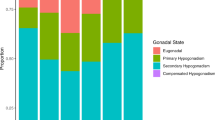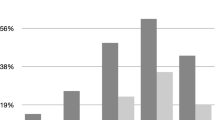Abstract
The primary objective of this study was to correlate simultaneous measures of prostate-specific antigen (PSA) and serum testosterone among large samples of eugonadal, untreated hypogonadal and hypogonadal men treated with testosterone replacement therapy (TRT). From 2001 to 2007, laboratory records were reviewed to identify men who underwent simultaneous measurement of PSA and serum testosterone levels. The data were stratified based on three groups of men: group 1 consisted of eugonadal men (T>300 ng per 100 ml) evaluated for BPH, reproductive failure or sexual dysfunction; group 2 consisted of untreated hypogonadal men (T<300 ng per 100 ml); and group 3 comprised symptomatic hypogonadal men receiving TRT. Correlations were found between PSA (total and free fractions) and total serum testosterone levels among the three groups. Group 1: eugonadal men (n=385 patients), mean PSA and serum testosterone were 1.60 ng ml−1 and 484 ng 100 ml, respectively. There was no significant correlation between PSA and total serum testosterone levels (r=−0.01, P=0.8). Group 2: untreated hypogonadal men (n=229 patients), mean PSA and serum testosterone were 1.49 ng ml−1 and 269 ng per 100 ml, respectively. There was no significant correlation between PSA and total serum testosterone levels (r=0.03, P=0.6). Group 3: hypogonadal men on TRT (n=229 patients and 994 individual samples analyzed) mean PSA and serum testosterone were 1.50 ng ml−1 and 555 ng per 100 ml, respectively. There was no significant correlation between PSA and serum testosterone levels (r=−0.005, P=0.9). Mean total serum testosterone levels were increased significantly (P<0.001) following treatment. Mean PSA levels did not increase in a statistically or clinically significant manner following TRT (mean PSA increase from baseline 0.05 ng ml−1, P=0.6). In conclusion, TRT does not appear to significantly influence serum PSA expression and no significant correlation was identified between PSA and serum testosterone among eugonadal, untreated hypogonadal and hypogonadal men receiving TRT.
This is a preview of subscription content, access via your institution
Access options
Subscribe to this journal
Receive 8 print issues and online access
$259.00 per year
only $32.38 per issue
Buy this article
- Purchase on Springer Link
- Instant access to full article PDF
Prices may be subject to local taxes which are calculated during checkout



Similar content being viewed by others
References
Huggins C, Hodges CV . The effect of castration, of estrogen and of androgen injection on serum phosphatases in metastatic cancer of the prostate. Cancer Res 1941; 293–297.
Fowler Jr JE, Whitmore Jr WF . The response of metastatic adenocarcinoma of the prostate to exogenous testosterone. J Urol 1981; 126: 372–375.
Prout GR, Brewer WR . Response of men with advanced prostatic carcinoma to exogenous administration of testosterone. Cancer 1967; 20: 1871–1878.
Rhoden EL, Morgentaler A . Risks of testosterone-replacement therapy and recommendations for monitoring. N Engl J Med 2004; 350: 482–492.
Rhoden EL, Morgentaler A . Testosterone replacement therapy in hypogonadal men at high risk for prostate cancer: results of 1 year of treatment in men with prostatic intraepithelial neoplasia. J Urol 2003; 170: 2348–2351.
Marks LS, Mazer NA, Mostaghel E, Hess DL, Dorey FJ, Epstein JI et al. Effect of testosterone replacement therapy on prostate tissue in men with late-onset hypogonadism: a randomized controlled trial. JAMA 2006; 296: 2351–2361.
Bhasin S, Cunningham GR, Hayes FJ, Matsumoto AM, Snyder PJ, Swerdloff RS et al. Testosterone therapy in adult men with androgen deficiency syndromes: endocrine society clinical practice guidelines. J Clin Endocrinol Metab 2006; 91: 1995–2010; http://www.endo-society.org/publications/guidelines/final/upload/AndrogensMenGuideline053006.pdf
Canadian Society for the Study of the Aging Male (CSSAM), www.canadianguidelines.com/PDF/01_Andropause.pdf.
Catalona WJ, Southwick PC, Slawin KM, Partin AW, Brawer MK, Flanigan RC et al. Comparison of percent free PSA, PSA density, and age-specific PSA cutoffs for prostate cancer detection and staging. Urology 2000; 56: 255–260.
Beaulac JA, Fry RN, Onysko J . Lifetime and recent prostate specific antigen (PSA) screening of men for prostate cancer in Canada. Can J Public Health 2006; 97: 171–176.
Monath JR, McCullough DL, Hart LJ, Jarow JP . Physiologic variations of serum testosterone within the normal range do not affect serum prostate-specific antigen. Urology 1995; 46: 58–61.
Mohr BA, Feldman HA, Kalish LA, Longcope C, McKinlay JB . Are serum hormones associated with the risk of prostate cancer? Prospective results from the Massachusetts Male Aging Study. Urology 2001; 57: 930–935.
Endogenous Hormones, Prostate Cancer Collaborative Group Roddam AW ## Allen NE ## Appleby P, Key TJ . Endogenous sex hormones and prostate cancer: a collaborative analysis of 18 prospective studies. J Natl Cancer Inst 2008; 100: 170–183.
Mearini L, Costantini E, Zucchi A, Mearini E, Bini V, Cottini E et al. Testosterone levels in benign prostatic hypertrophy and prostate cancer. Urol Int 2008; 80: 134–140. E-pub 2008 March 19.
Rhoden EL, Riedner CE, Morgentaler A . The ratio of serum testosterone-to-prostate specific antigen predicts prostate cancer in hypogonadal men. J Urol 2008; 179: 1741–1744.
Douglas TH, Connelly RR, McLeod DG, Erickson SJ, Barren III R, Murphy GP . Effect of exogenous testosterone replacement on prostate-specific antigen and prostate-specific membrane antigen levels in hypogonadal men. J Surg Oncol 1995; 59: 246–250.
Gerstenbluth RE, Maniam PN, Corty EW, Seftel AD . Prostate-specific antigen changes in hypogonadal men treated with testosterone replacement. J Androl 2002; 23: 922–926.
Rhoden EL, Morgentaler A . Influence of demographic factors and biochemical characteristics on the prostate-specific antigen (PSA) response to testosterone replacement therapy. Int J Impot Res 2006; 18: 201–205.
Saad F, Gooren L, Haider A, Yassin A . An exploratory study of the effects of 12 month administration of the novel long-acting testosterone undecanoate on measures of sexual function and the metabolic syndrome. Arch Androl 2007; 53: 353–357.
Morgentaler A . Testosterone and prostate cancer: an historical perspective on a modern myth. Eur Urol 2006; 50: 935–939.
Stone NN, Clejan SJ . Response of prostate volume, prostate-specific antigen, and testosterone to flutamide in men with benign prostatic hyperplasia. J Androl 1991; 12: 376–380.
Kaku H, Saika T, Tsushima T, Ebara S, Senoh T, Yamato T et al. Time course of serum testosterone and luteinizing hormone levels after cessation of long-term luteinizing hormone-releasing hormone agonist treatment in patients with prostate cancer. Prostate 2006; 66: 439–444.
Goldenberg SL, Bruchovsky N, Gleave ME, Sullivan LD, Akakura K . Intermittent androgen suppression in the treatment of prostate cancer: a preliminary report. Urology 1995; 45: 839–844.
Akyol F, Ozyigit G, Selek U, Karabulut E . PSA bouncing after short term androgen deprivation and 3D-conformal radiotherapy for localized prostate adenocarcinoma and the relationship with the kinetics of testosterone. Eur Urol 2005; 48: 40–45.
Acknowledgements
The authors acknowledge the following potential conflicts of interest: Dr Ethan D Grober: Auxilium—speaker; Solvay—speaker, advisory board. Dr Mohit Khera: Auxilium—speaker, investigator; Solvay—investigator. Dr Larry I Lipshultz: Auxilium—advisory board, investigator, speaker; Solvay—speaker.
Author information
Authors and Affiliations
Corresponding author
Rights and permissions
About this article
Cite this article
Grober, E., Lamb, D., Khera, M. et al. Correlation between simultaneous PSA and serum testosterone concentrations among eugonadal, untreated hypogonadal and hypogonadal men receiving testosterone replacement therapy. Int J Impot Res 20, 561–565 (2008). https://doi.org/10.1038/ijir.2008.40
Received:
Revised:
Accepted:
Published:
Issue Date:
DOI: https://doi.org/10.1038/ijir.2008.40
Keywords
This article is cited by
-
Association Between Serum Testosterone and Serum PSA Among Men With and Without Partial Androgen Deficiency
Indian Journal of Clinical Biochemistry (2020)
-
Androgen Replacement Therapy After Prostate Cancer Treatment
Current Urology Reports (2010)



